GMC ENVOY DENALI 2007 Owners Manual
Manufacturer: GMC, Model Year: 2007, Model line: ENVOY DENALI, Model: GMC ENVOY DENALI 2007Pages: 562, PDF Size: 2.87 MB
Page 351 of 562
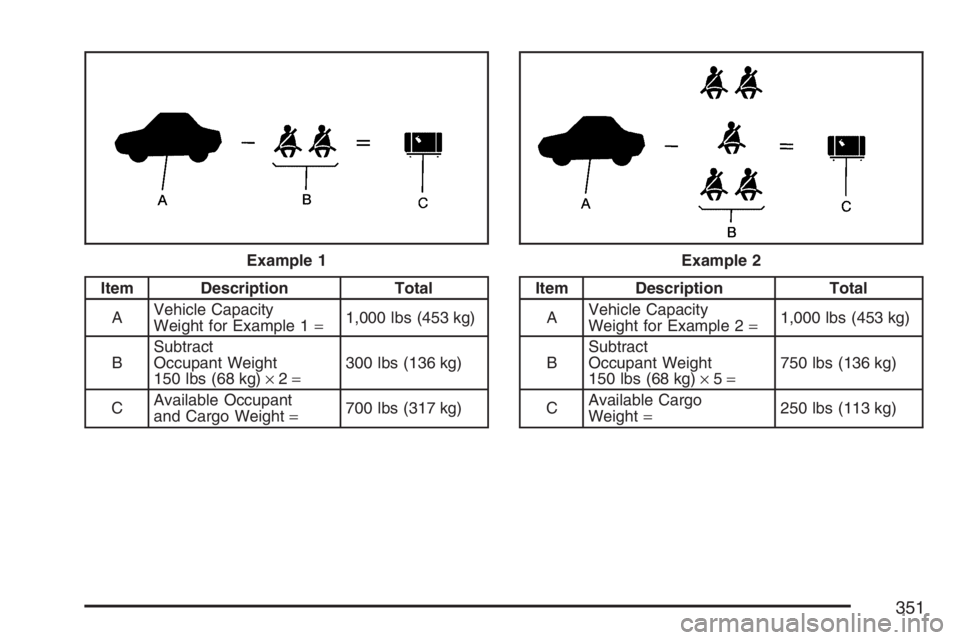
Item Description Total
AVehicle Capacity
Weight for Example 1=1,000 lbs (453 kg)
BSubtract
Occupant Weight
150 lbs (68 kg)×2=300 lbs (136 kg)
CAvailable Occupant
and Cargo Weight=700 lbs (317 kg)Item Description Total
AVehicle Capacity
Weight for Example 2=1,000 lbs (453 kg)
BSubtract
Occupant Weight
150 lbs (68 kg)×5=750 lbs (136 kg)
CAvailable Cargo
Weight=250 lbs (113 kg) Example 1
Example 2
351
Page 352 of 562
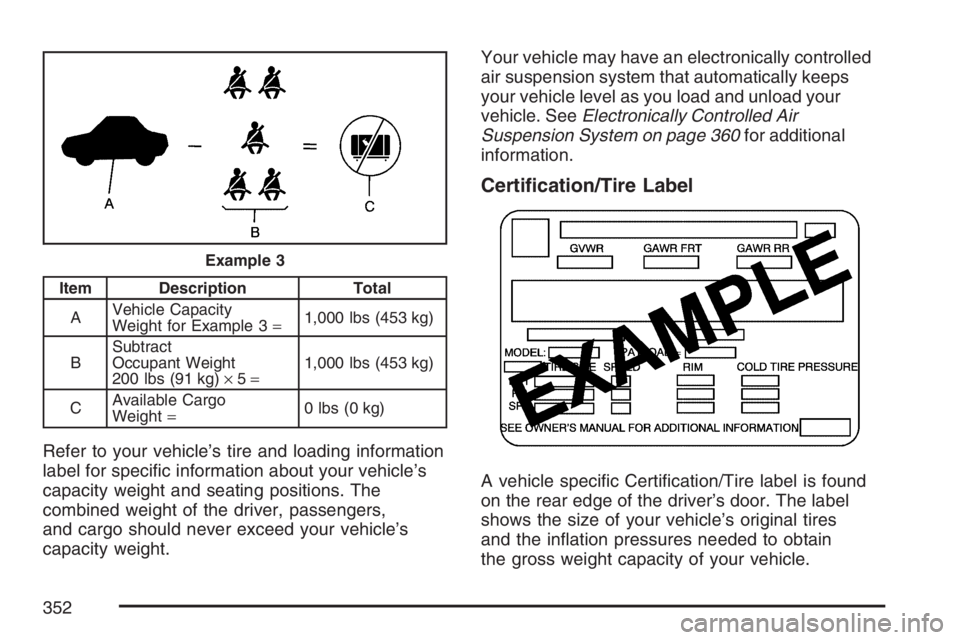
Item Description Total
AVehicle Capacity
Weight for Example 3=1,000 lbs (453 kg)
BSubtract
Occupant Weight
200 lbs (91 kg)×5=1,000 lbs (453 kg)
CAvailable Cargo
Weight=0 lbs (0 kg)
Refer to your vehicle’s tire and loading information
label for speci�c information about your vehicle’s
capacity weight and seating positions. The
combined weight of the driver, passengers,
and cargo should never exceed your vehicle’s
capacity weight.Your vehicle may have an electronically controlled
air suspension system that automatically keeps
your vehicle level as you load and unload your
vehicle. SeeElectronically Controlled Air
Suspension System on page 360for additional
information.
Certi�cation/Tire Label
A vehicle speci�c Certi�cation/Tire label is found
on the rear edge of the driver’s door. The label
shows the size of your vehicle’s original tires
and the in�ation pressures needed to obtain
the gross weight capacity of your vehicle.
Example 3
352
Page 353 of 562
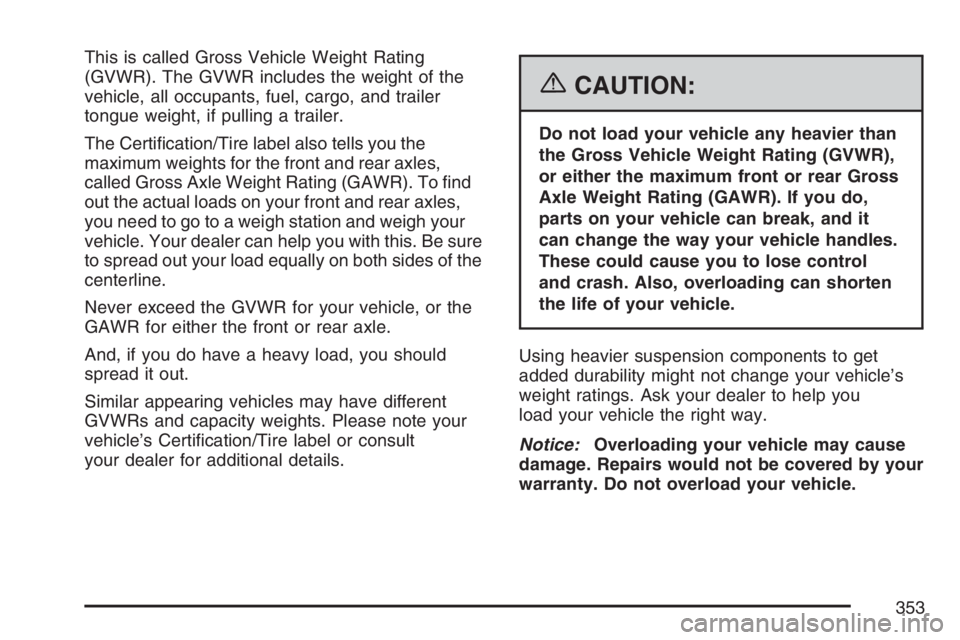
This is called Gross Vehicle Weight Rating
(GVWR). The GVWR includes the weight of the
vehicle, all occupants, fuel, cargo, and trailer
tongue weight, if pulling a trailer.
The Certi�cation/Tire label also tells you the
maximum weights for the front and rear axles,
called Gross Axle Weight Rating (GAWR). To �nd
out the actual loads on your front and rear axles,
you need to go to a weigh station and weigh your
vehicle. Your dealer can help you with this. Be sure
to spread out your load equally on both sides of the
centerline.
Never exceed the GVWR for your vehicle, or the
GAWR for either the front or rear axle.
And, if you do have a heavy load, you should
spread it out.
Similar appearing vehicles may have different
GVWRs and capacity weights. Please note your
vehicle’s Certi�cation/Tire label or consult
your dealer for additional details.
{CAUTION:
Do not load your vehicle any heavier than
the Gross Vehicle Weight Rating (GVWR),
or either the maximum front or rear Gross
Axle Weight Rating (GAWR). If you do,
parts on your vehicle can break, and it
can change the way your vehicle handles.
These could cause you to lose control
and crash. Also, overloading can shorten
the life of your vehicle.
Using heavier suspension components to get
added durability might not change your vehicle’s
weight ratings. Ask your dealer to help you
load your vehicle the right way.
Notice:Overloading your vehicle may cause
damage. Repairs would not be covered by your
warranty. Do not overload your vehicle.
353
Page 354 of 562
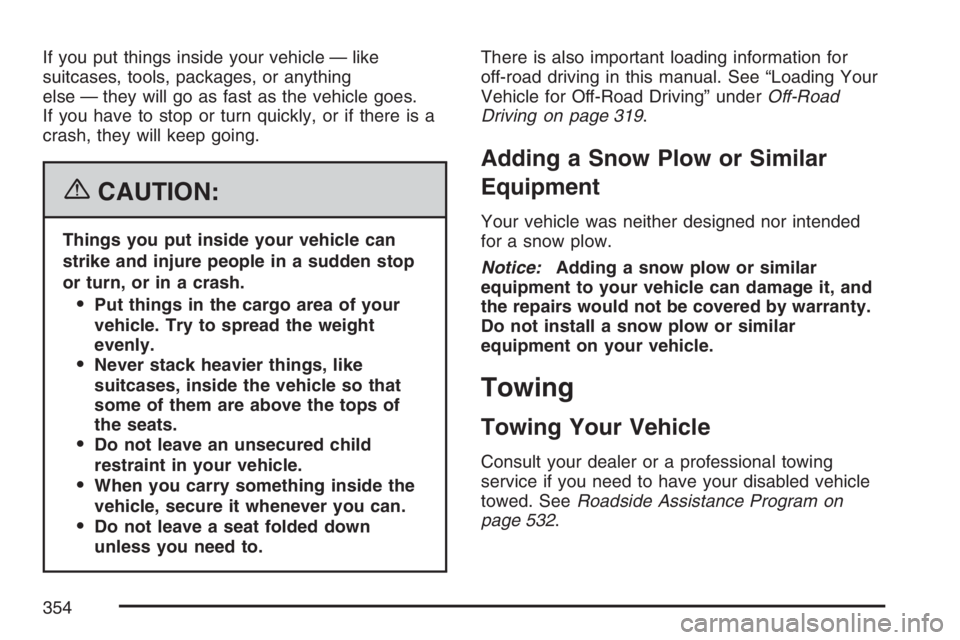
If you put things inside your vehicle — like
suitcases, tools, packages, or anything
else — they will go as fast as the vehicle goes.
If you have to stop or turn quickly, or if there is a
crash, they will keep going.
{CAUTION:
Things you put inside your vehicle can
strike and injure people in a sudden stop
or turn, or in a crash.
Put things in the cargo area of your
vehicle. Try to spread the weight
evenly.
Never stack heavier things, like
suitcases, inside the vehicle so that
some of them are above the tops of
the seats.
Do not leave an unsecured child
restraint in your vehicle.
When you carry something inside the
vehicle, secure it whenever you can.
Do not leave a seat folded down
unless you need to.There is also important loading information for
off-road driving in this manual. See “Loading Your
Vehicle for Off-Road Driving” underOff-Road
Driving on page 319.
Adding a Snow Plow or Similar
Equipment
Your vehicle was neither designed nor intended
for a snow plow.
Notice:Adding a snow plow or similar
equipment to your vehicle can damage it, and
the repairs would not be covered by warranty.
Do not install a snow plow or similar
equipment on your vehicle.
Towing
Towing Your Vehicle
Consult your dealer or a professional towing
service if you need to have your disabled vehicle
towed. SeeRoadside Assistance Program on
page 532.
354
Page 355 of 562
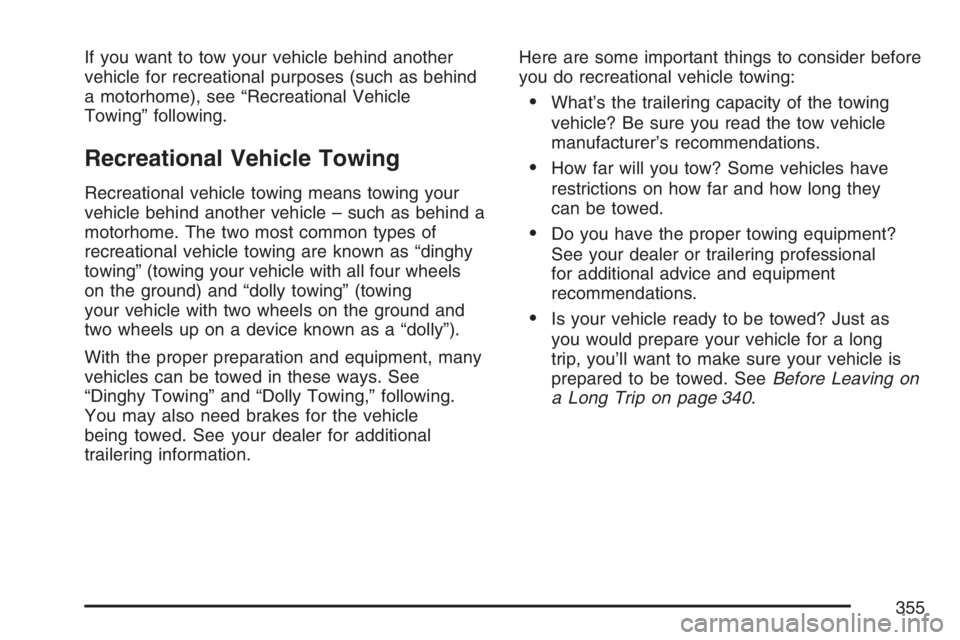
If you want to tow your vehicle behind another
vehicle for recreational purposes (such as behind
a motorhome), see “Recreational Vehicle
Towing” following.
Recreational Vehicle Towing
Recreational vehicle towing means towing your
vehicle behind another vehicle – such as behind a
motorhome. The two most common types of
recreational vehicle towing are known as “dinghy
towing” (towing your vehicle with all four wheels
on the ground) and “dolly towing” (towing
your vehicle with two wheels on the ground and
two wheels up on a device known as a “dolly”).
With the proper preparation and equipment, many
vehicles can be towed in these ways. See
“Dinghy Towing” and “Dolly Towing,” following.
You may also need brakes for the vehicle
being towed. See your dealer for additional
trailering information.Here are some important things to consider before
you do recreational vehicle towing:
What’s the trailering capacity of the towing
vehicle? Be sure you read the tow vehicle
manufacturer’s recommendations.
How far will you tow? Some vehicles have
restrictions on how far and how long they
can be towed.
Do you have the proper towing equipment?
See your dealer or trailering professional
for additional advice and equipment
recommendations.
Is your vehicle ready to be towed? Just as
you would prepare your vehicle for a long
trip, you’ll want to make sure your vehicle is
prepared to be towed. SeeBefore Leaving on
a Long Trip on page 340.
355
Page 356 of 562
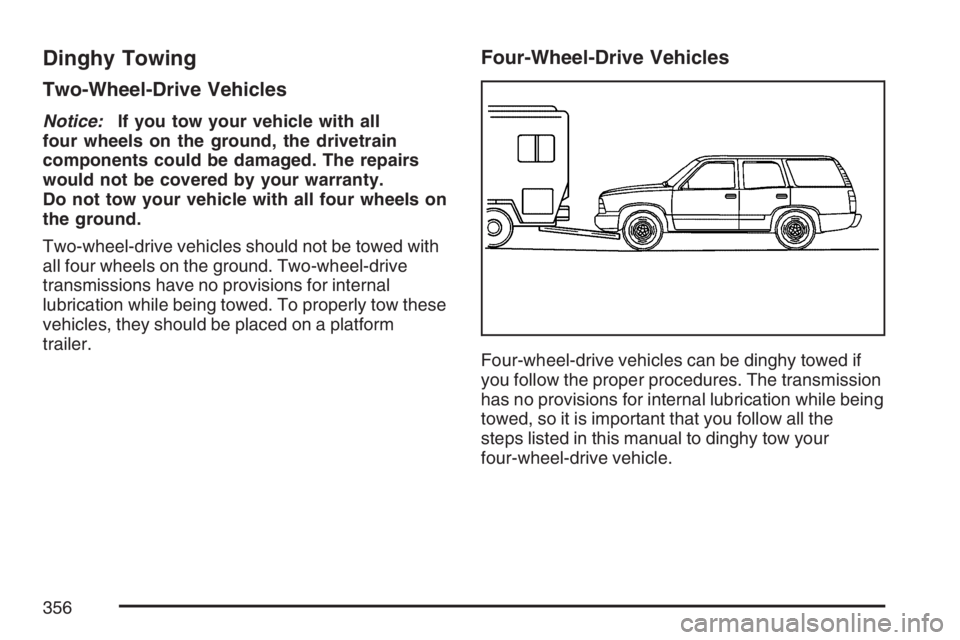
Dinghy Towing
Two-Wheel-Drive Vehicles
Notice:If you tow your vehicle with all
four wheels on the ground, the drivetrain
components could be damaged. The repairs
would not be covered by your warranty.
Do not tow your vehicle with all four wheels on
the ground.
Two-wheel-drive vehicles should not be towed with
all four wheels on the ground. Two-wheel-drive
transmissions have no provisions for internal
lubrication while being towed. To properly tow these
vehicles, they should be placed on a platform
trailer.
Four-Wheel-Drive Vehicles
Four-wheel-drive vehicles can be dinghy towed if
you follow the proper procedures. The transmission
has no provisions for internal lubrication while being
towed, so it is important that you follow all the
steps listed in this manual to dinghy tow your
four-wheel-drive vehicle.
356
Page 357 of 562
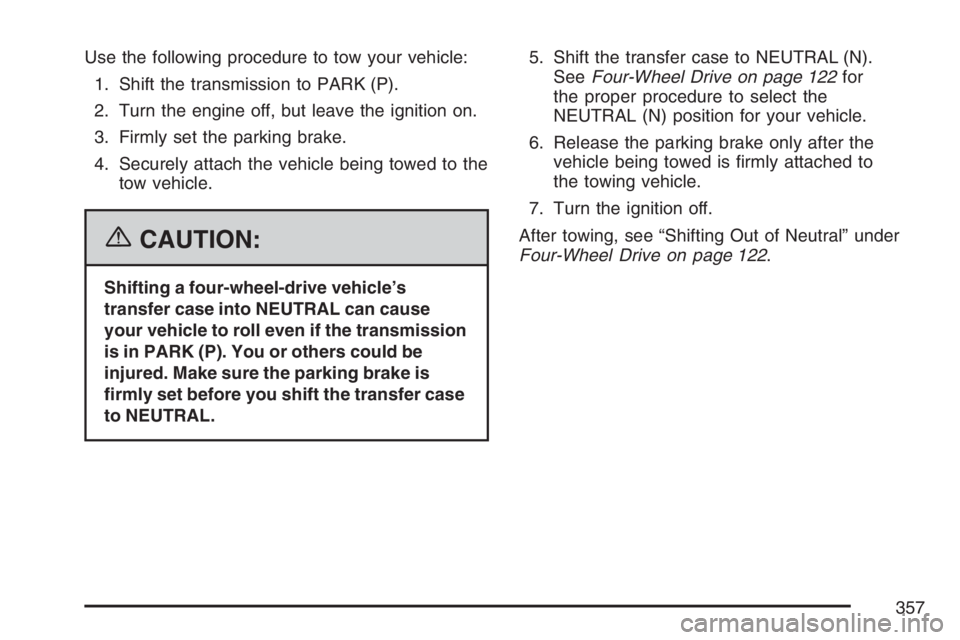
Use the following procedure to tow your vehicle:
1. Shift the transmission to PARK (P).
2. Turn the engine off, but leave the ignition on.
3. Firmly set the parking brake.
4. Securely attach the vehicle being towed to the
tow vehicle.
{CAUTION:
Shifting a four-wheel-drive vehicle’s
transfer case into NEUTRAL can cause
your vehicle to roll even if the transmission
is in PARK (P). You or others could be
injured. Make sure the parking brake is
�rmly set before you shift the transfer case
to NEUTRAL.5. Shift the transfer case to NEUTRAL (N).
SeeFour-Wheel Drive on page 122for
the proper procedure to select the
NEUTRAL (N) position for your vehicle.
6. Release the parking brake only after the
vehicle being towed is �rmly attached to
the towing vehicle.
7. Turn the ignition off.
After towing, see “Shifting Out of Neutral” under
Four-Wheel Drive on page 122.
357
Page 358 of 562

Dolly Towing
Front Towing
(Front Wheels Off the Ground)
Two-Wheel-Drive Vehicles
Notice:If you tow a two-wheel-drive vehicle
with the rear wheels on the ground, the
transmission could be damaged. The repairs
would not be covered by your warranty.
Never tow your vehicle with the rear wheels on
the ground.
Four-Wheel-Drive Vehicles
Four-wheel-drive vehicles can be dolly towed with
the rear wheels on the ground.
Use the following procedure to tow your vehicle:
1. Drive the vehicle onto the tow dolly.
2. Shift the automatic transmission to PARK (P).
3. Turn the engine off, but leave the ignition on.
4. Firmly set the parking brake.
5. Securely attach the vehicle being towed to
the dolly.
{CAUTION:
Shifting a four-wheel-drive vehicle’s
transfer case into NEUTRAL can cause
your vehicle to roll even if the transmission
is in PARK (P). You or others could be
injured. Make sure the parking brake is
�rmly set before you shift the transfer case
to NEUTRAL.
6. Shift the transfer case to NEUTRAL (N).
SeeFour-Wheel Drive on page 122for
the proper procedure to select the
NEUTRAL (N) position for your vehicle.
7. Release the parking brake only after the
vehicle being towed is �rmly attached to
the towing vehicle.
8. Turn the ignition off.
After towing, see “Shifting Out of Neutral”
underFour-Wheel Drive on page 122.
358
Page 359 of 562
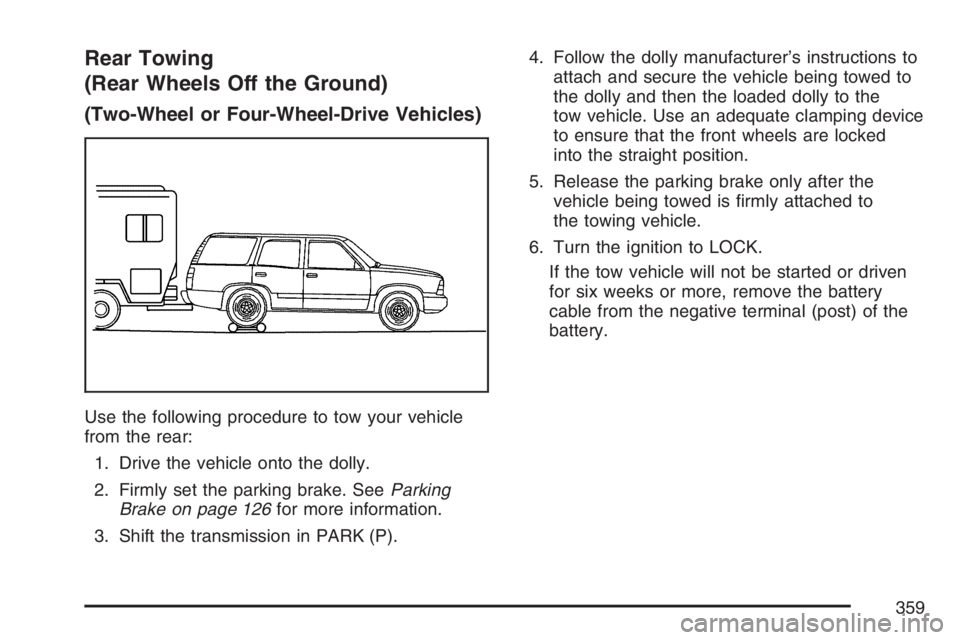
Rear Towing
(Rear Wheels Off the Ground)
(Two-Wheel or Four-Wheel-Drive Vehicles)
Use the following procedure to tow your vehicle
from the rear:
1. Drive the vehicle onto the dolly.
2. Firmly set the parking brake. SeeParking
Brake on page 126for more information.
3. Shift the transmission in PARK (P).4. Follow the dolly manufacturer’s instructions to
attach and secure the vehicle being towed to
the dolly and then the loaded dolly to the
tow vehicle. Use an adequate clamping device
to ensure that the front wheels are locked
into the straight position.
5. Release the parking brake only after the
vehicle being towed is �rmly attached to
the towing vehicle.
6. Turn the ignition to LOCK.
If the tow vehicle will not be started or driven
for six weeks or more, remove the battery
cable from the negative terminal (post) of the
battery.
359
Page 360 of 562
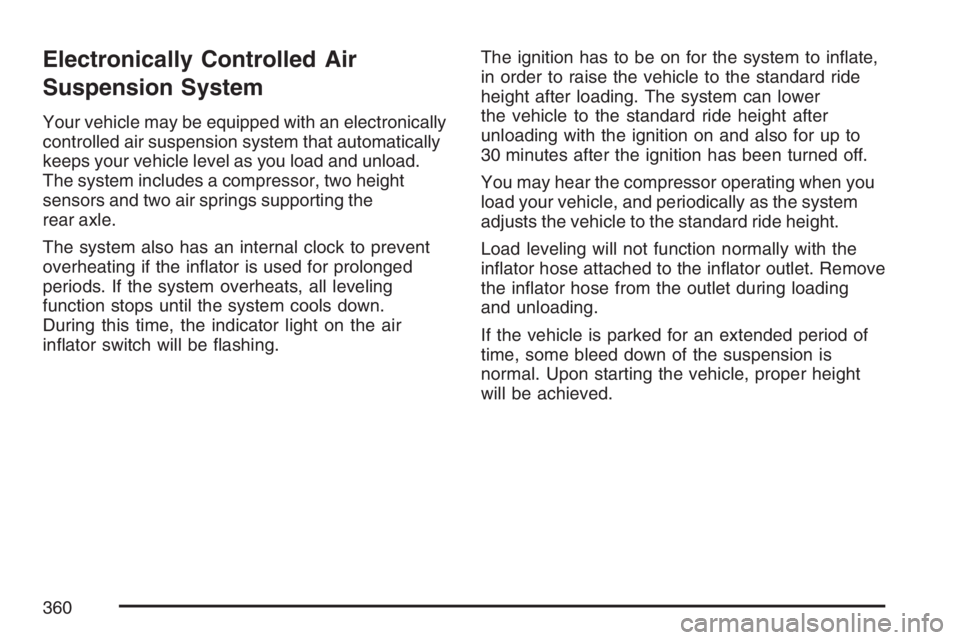
Electronically Controlled Air
Suspension System
Your vehicle may be equipped with an electronically
controlled air suspension system that automatically
keeps your vehicle level as you load and unload.
The system includes a compressor, two height
sensors and two air springs supporting the
rear axle.
The system also has an internal clock to prevent
overheating if the in�ator is used for prolonged
periods. If the system overheats, all leveling
function stops until the system cools down.
During this time, the indicator light on the air
in�ator switch will be �ashing.The ignition has to be on for the system to in�ate,
in order to raise the vehicle to the standard ride
height after loading. The system can lower
the vehicle to the standard ride height after
unloading with the ignition on and also for up to
30 minutes after the ignition has been turned off.
You may hear the compressor operating when you
load your vehicle, and periodically as the system
adjusts the vehicle to the standard ride height.
Load leveling will not function normally with the
in�ator hose attached to the in�ator outlet. Remove
the in�ator hose from the outlet during loading
and unloading.
If the vehicle is parked for an extended period of
time, some bleed down of the suspension is
normal. Upon starting the vehicle, proper height
will be achieved.
360